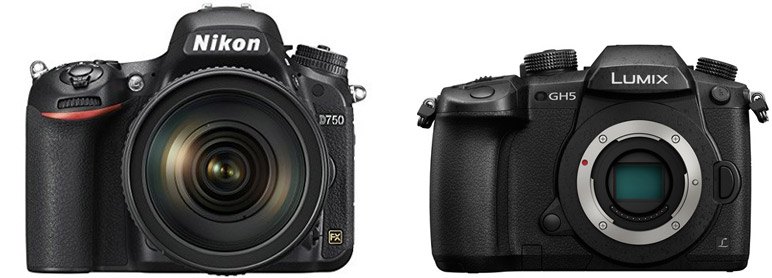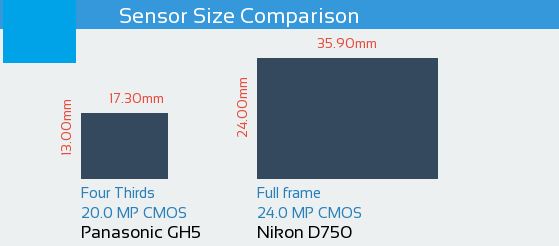Nikon D750 vs Panasonic GH5
: Here we take a look at the Nikon D750 and the Panasonic GH5. These are cameras with different body types. The D750 is a semi-pro Nikon full frame camera and the GH5 is a professional mirrorless camera. However, before we go any further, let’s have a brief look at the main features of Panasonic GH5 and Nikon D750.
Panasonic GH5 vs Nikon D750 Specs
The Panasonic GH5 is a Pro Mirrorless camera whereas Nikon D750 is a Semi-Pro DSLR camera. The difference here lies in the body type. Mirrorless cameras are much more lightweight than their DSLR counterparts. However, DSLRs have been known to perform better than most mirrorless cameras. Although, with recent advancements in focus speeds and design, mirrorless cameras serve as good alternatives to DSLRs. Take a look at the specifications before a detailed overview.

Nikon D750 & Panasonic GH5
Specfications |
Nikon D750 |
Panasonic GH5 |
|---|---|---|
| Megapixels | 24.3 | 20.3 |
| Sensor Type | CMOS | Live MOS |
| Sensor Format | Full Frame (FX) | Micro Four Thirds |
| Crop Factor | None | 2.0x |
| AA Filter | Yes | None |
| Image Resolution | 6016 x 4016 | 5184 x 3888 |
| Body Image Stabilization | No | Yes |
| Lens Mount | Nikon FX | Micro Four Thirds |
| ISO | 100 – 12,800 | 200 – 25,600 |
| Expanded ISO | 50 – 51,200 | 100 |
| AF Points | 51 | 225 Contrast |
| Cross-type AF Points | 15 | 0 phase |
| Continuous Mode | 6.5fps | 12fps |
| LCD | 3.2″ – Articulating | 3.2″ – Fully Articulated |
| LCD Resolution | 1,229,000 dots | 1,620,000 dots |
| Touchscreen | No | Yes |
| Focus Peaking | No | Yes |
| Top LCD Display | Yes | No |
| Viewfinder Type | Optical | EVF (3.68M) |
| Viewfinder Coverage | 100% | 100% |
| Viewfinder Magnification | 0.70x | 1.52x |
| Video Resolution | 1920×1080 (60/50/30/25/24p) | 4096×2160 (24p) |
| 1280×720 (60/50p) | 3840×2160 (60/50/30/25/24p) | |
| Microphone Jack | Yes | Yes |
| Headphone Jack | Yes | Yes |
| Memory Card Type | SD + SD | SD + SD |
| Dual Card Slots | Yes | Yes |
| SD UHS Support | UHS-I | UHS-II |
| Fastest Shutter Speed | 1/4000 | 1/16000 |
| Slowest Shutter Speed | 30″ | 60″ |
| Bulb Mode | Yes | Yes |
| JPEG Buffer Size | 40 | 600 |
| RAW Buffer Size | 10 | 60 |
| Time Lapse | Yes | Yes |
| Built-in Flash | Yes | No |
| Max Flash Sync Speed | 1/250 | 1/250 |
| Startup Time | 0.5s | |
| Built-in Wi-Fi | Yes | Yes |
| Built-in GPS | No | No |
| Built-in NFC | No | No |
| Bluetooth | No | Yes |
| USB Type | USB 2.0 | USB 3.0 |
| Environmentally Sealed | Yes | Yes |
| Battery Life (CIPA) | 1230 shots | 410 shots |
| Battery Included | Yes (EN-EL15) | Yes |
| Weight | 26.5 oz (750g) | 25.6 oz (725g) |
| Size | 5.5 x 4.4 x 3.1″ | 5.5 x 3.9 x 3.4″ |
| Price | Amazon | Amazon |
| Release Date | 2014 | 2017 |
Panasonic GH5 – Nikon D750 Common Features
| Wireless Connection | Yes vs Yes | Better connectivity |
| Articulating Screen | Yes vs Yes | Flexible shooting positions |
| External Flash Shoe | Yes vs Yes | Better for flash photography |
| Viewfinder | Yes (Electronic) vs Yes (Optical) | Better framing and control |
| RAW Support | Yes vs Yes | Better image quality |
| Face Detection Focus | Yes vs Yes | very handy for portraits |
| Max Resolution | 20 MP vs 24 MP | Bigger prints and more details |
| LCD Screen Size | 3.2″ vs 3.2″ | Large display |
| Continuous Shooting | 12.0fps vs 6.5fps | Fast shooting speeds |
| Microphone Port | Yes vs Yes | High-quality audio recording option |
| Headphone Port | Yes vs Yes | better video control |
| Environmental Sealing | Yes vs Yes | shoot at tough conditions |
| Timelapse Recording | Yes vs Yes | creative shooting |
| AE Bracketing | Yes vs Yes | Useful for tough lighting conditions and HDR |
| Storage Slot | 2 vs 2 | Extra Storage Slot |
| Smartphone Remote Control | Yes vs Yes | Remote control your camera with a smartphone |
Nikon D750 vs Panasonic GH5: Size Comparison
The Panasonic GH5 is 2mm narrower and 15mm shorter than Nikon D750 however it is also 9mm thicker. So, they roughly are close in size.

Nikon D750 & Panasonic GH5
The same is true for the weight of both cameras. The Panasonic GH5 is 115g lighter than the Nikon D750. Again, this is not a significant difference.
Nikon D750 vs Panasonic GH5: Sensor Comparison
The Panasonic GH5 has a 20.0MP Four Thirds (17.3 x 13 mm ) sized CMOS sensor and features Venus Engine processor. In comparison, the Nikon D750 has a 24.0MP Full frame (35.9 x 24 mm ) sized CMOS sensor and features Expeed 4 processor.
Another key difference between these two cameras is that the Panasonic GH5’s sensor lacks an anti-alias (Low-Pass) filter. Removing the anti-alias filter increases the sharpness and level of detail but, at the same time, it increases the chance of watery overlays occurring in certain pictures.

Panasonic Lumix DMC GH5 vs Nikon D750 Sensor Comparison
The Nikon D750 has a 3.8x larger sensor area than Panasonic GH5. Larger sensors provide more control of the depth of field and blurry background compared to the smaller sensor when shot in same focal length and aperture.
Nikon D750 Advantages Over Panasonic GH5
| Built-in Image Stabilization | Sensor-shift vs None | All the lenses are stabilized |
| Touch Screen | Yes vs No | Easy control of camera functions |
| Max ISO | 25.600 vs 12.800 | 100% higher Max ISO |
| Number of Focus Points | 225 vs 51 | 174 more focus points |
| LCD Screen Resolution | 1.620k dots vs 1.229k dots | 31% higher resolution screen |
| Max Shutter Speed | 1/8000s vs 1/4000s | faster shutter speed |
| Continuous Shooting | 12.0fps vs 6.5fps | 5.5 fps faster |
| Weight | 725 g vs 840 g | 115 g lighter |
| Price | $1,998 vs $2,000 | $2 cheaper |
| Max Video Resolution | 4096 x 2160 vs 1920 x 1080 | Higher Resolution Video |
| Flash Sync Port | Yes vs No | Connect off-camera flash |
| 4K Photo Mode | Yes vs No | Extract 8MP photos from 4K Video |
| 6K Photo Mode | Yes vs No | Extract 18MP photos from Video footage |
| Bluetooth | Yes vs No | Connect your camera to other devices via Bluetooth |
| Focus Stacking | Yes vs No | Stacks photos in-camera to maximize depth of field |
| Post Focus Mode | Yes vs No | Change focus point after taking a shot |
| Support for UHS Memory Cards | UHS-IIvsnone | Read/Write in Ultra High Speeds |
Here are the key points to note from the above table:
- Megapixels – 4.0 more megapixels. For printing big and cropping, the Nikon D750 is a much better choice.
- Sensor Format – Full Frame is bigger than MFT. When shooting above ISO 3,200, the difference in image quality is significantly bigger.
- ISO – 51,200 vs 25,600. Higher maximum ISO sensitivity.
- Top LCD Display – When shooting in semi-auto/manual modes, you can quickly preview all of your settings.
- Built-in Flash
- Battery Life – 1230 shots vs 410 shots.
Video: Nikon D750 Hands-on Review
Panasonic GH5 Advantages Over Nikon D750
| Built-in Flash | YesvsNo | Useful in low-light |
| Max Sensor Resolution | 24 MP vs 20 MP | 19% more pixels |
| Battery Life | 1230 shots vs 410 shots | 820 more frames with a single charge |
| Sensor Pixel Area | 35.66µm2 vs 11.16µm2 | 219% larger pixel area |
| Top LCD | Yes vs No | Helps to view and changing settings easily |
| Autofocus at f/8 aperture | 11 points vs none | Autofocus with teleconverters |
Here are the key points to take away from the chart:
- AA Filter – The Panasonic GH5 has no AA filter.
- Body Image Stabilization – The Panasonic GH5 has built-in body stabilization for photos and videos, which is an excellent feature for traveling and shooting in low light.
- AF Points – 255 Contrast vs 51.
- Continuous mode – 12fps vs 6.5fps. More is better for sports and wildlife since you have more chances of getting a tack sharp shot.
- LCD – It’s fully articulated.
- LCD Resolution – Higher resolution.
- Touchscreen Support
- Focus Peaking – Very useful for seeing if your subject is in focus (both photo and video).
- Viewfinder Magnification – Higher magnification.
- Video Resolution – 4K video available.
- UHS-II – Faster writing speeds than UHS-I, but you need a memory card that can handle such speeds.
- Faster Max Shutter Speed – 1/16000 vs 1/4000.
- Slower Max Shutter Speed – 60” vs 30”.
- JPEG Buffer Size – 600 vs 40.
- RAW Buffer Size – 60 vs 10.
- Bluetooth Support
- USB 3.0 – Faster file transferring out the camera.
Video: Panasonic GH5 Hands-On Review
You Might Also Like
- Canon M5 vs Nikon D7200: A Complete Comparison
- Canon M5 vs Nikon D5600: A Complete Comparison
- Canon M5 vs Canon M6: A Complete Comparison
- Canon M5 vs Olympus E-M5 II: A Complete Comparison
- Canon M5 vs Nikon D5500: A Complete Comparison
- Canon M5 vs Pentax KP: A Detailed Comparison
- Canon M5 vs Sony A6500: A Detailed Comparison
- Canon M5 vs Fujifilm X-Pro2: A Detailed Comparison
- Canon M5 vs Fujifilm X-T2: A Detailed Comparison
- Nikon D7200 vs Sony A6300: A Complete Comparison
- Canon M5 vs Fujifilm X-T20: A Detailed Comparison
- Canon M5 vs Nikon D7100: A Complete Comparison
- Canon M5 vs Nikon D3300: A Complete Comparison
- Canon M5 vs Nikon D3400: A Complete Comparison